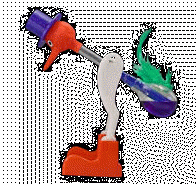|
Lesson |
Learning Outcomes |
Notes |
|
1 - Radiation I |
-
Know that radiation is absorbed and
emitted by all objects.
-
Be able to compare the effectiveness of
different surfaces as emitters, by considering the nature of
the surface.
|
Key terms: infrared, emission, absorption. |
|
2 -
Radiation II |
-
Be able to compare the effectiveness of
different surfaces as absorbers, by considering the nature
of the surface.
-
Be able to describe and explain how these
properties are used to design more effective appliances and
buildings.
|
|
|
3 - Kinetic Theory |
-
Be able to describe the differences
between the arrangement of the particles in solids, liquids
and gases.
-
Use these concepts to explain the
behaviour of materials undergoing heating in a variety of
contexts.
|
key terms: particles, expand, contract
higher: atoms, molecules |
|
4 - Conduction
|
|
Key terms: atom, vibrate, conduct, conductor,
insulator
higher: vibrational energy,
ion, free electron
|
|
5 - Conduction II
Extended
writing opportunity |
|
Key terms: atom, vibrate, conduct, conductor,
insulator
higher: vibrational energy,
ion, free electron
|
|
6 - Convection |
|
Key terms: convection, convection current, rise,
sink
higher: density, ascend, descend,
energy, particles
|
|
7 - Convection II |
-
Observe two demonstrations showing
convection in a beaker and a large tank of water
-
Describe weather systems in terms of the movement and changing density of regions of
air undergoing heating and cooling.
|
Key terms: convection, convection current, rise,
sink
higher: density, ascend, descend,
energy, particles
|
|
8 - Evaporation and condensation I
Extended writing opportunity |
|
Key terms: evaporation, condensation, particles,
energetic, distribution, escape, average thermal energy, rate,
heat, cooling, trapped. |
|
9 - Evaporation and condensation II |
-
Investigate factors affecting the rate of evaporation.
-
Compare the cooling effect produced as
the rate of evaporation is altered.
-
Describe and explain processes involving
evaporation and condensation, and compare different
scenarios in terms of the rate of evaporation.
|
Key terms: evaporation, condensation, particles,
energetic, distribution, escape, average thermal energy, rate,
heat, cooling, trapped. |
|
10 - Energy transfer by heating I |
|
|
|
11 - Comparing energy transfers |
|
|
|
12 - Heating and insulating buildings |
-
Be aware of the main areas heat energy is lost from a
building.
-
Describe a range of methods that can be used to reduce
heat loss from a building.
-
Explain how the various methods of reducing heat loss
work in terms of conduction, convection and radiation of
heat energy.
|
|
|
13 - U Values |
-
Understand that U-values can be used to compare the
effectiveness of different insulating materials.
-
Be able to compare the effectiveness of different
insulating materials, given their U-values.
-
Know the definition of a U-value and be able to carry
out calculations of the amount of heat lost from various
parts of the building, given information about the
dimensions, U-values and temperature difference.
|
|
|
14 - Solar Panels and Payback time |
-
Know that
-
Be able to
-
Be able to
|
|
|
15 - Specific Heat Capacity |
-
Know that
-
Be able to
-
Be able to
|
|
|
16 - Uses of Specific Heat Capacity |
-
Know that
-
Be able to
-
Be able to
|
|

